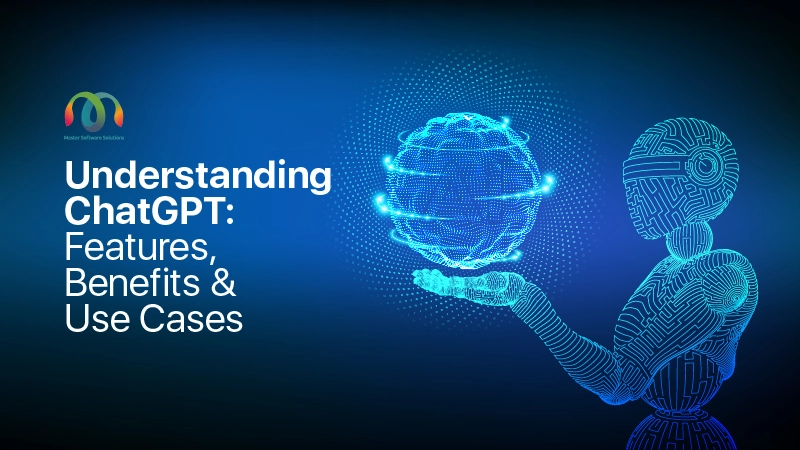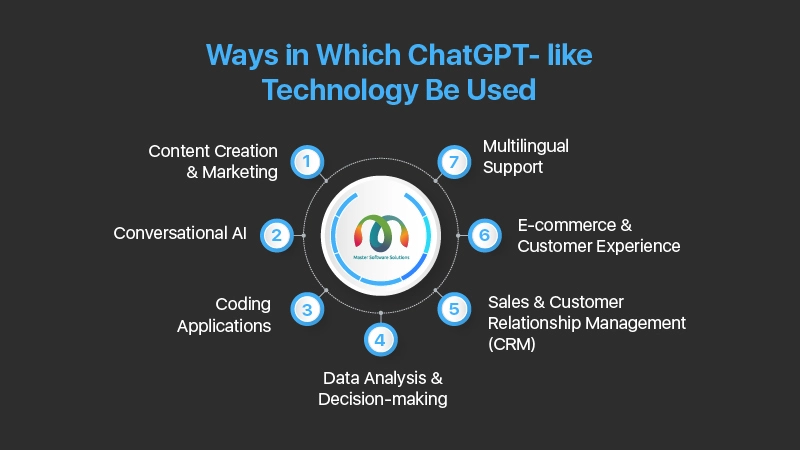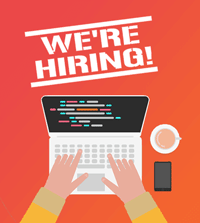Understanding ChatGPT: Features, Benefits And Use Cases

Businesses are constantly looking for novel ways to improve productivity, efficiency, and customer engagement in the changing world of technology. ChatGPT uses artificial intelligence (AI) in GPT-3.5, which was created by OpenAI. In this blog post, we will delve into the world of ChatGPT to gain insights into what it is, what it can do, and how you can easily integrate similar AI-powered technologies into your company to open up new doors and reap tangible rewards.
What is ChatGPT?
ChatGPT is an AI-generated chatbot that composes text in a manner similar to that of a human. It is a flexible tool with a wide range of applications trained on a significant amount of text data from the internet. It can understand natural language, respond to context, support multiple languages, and produce coherent and contextually relevant text.
Who created ChatGPT?
OpenAI, an AI research company founded by prominent players including Elon Musk, Sam Altman and Peter Theil (CEO of OpenAI), Ilya Sutskever, Jessica Livingston and Reid Hoffman (co-founder of LinkedIn), created ChatGPT. It was first introduced in a research paper titled ‘Transformer: A Novel Neural Network Architecture for Language Understanding’ by Google AI in August 2017.
Ilya Sutskever, Chief Scientist at OpenAI, an AI research company, wrote ChatGPT. This is an exhaustive answer, with Ilya being the most senior member; however, a team of engineers with the task of ML development was involved.
The first ChatGPT model, GPT-1 was developed in February 2018, followed by GPT-2 in January 2019. Then GPT-3 was introduced in June 2020 and now we have the latest model, GPT-4 which was launched in March 2023.
How does ChatGPT work?
ChatGPT operates via a Generative Pre-trained Transformer (GPT) to detect patterns in the data sequence by using technical algorithms. This AI-generated chatbot originally used the GBT-3 large model, the neural network machine learning model, and the third generation of GPT.
GBT-3 – It is also known as a third-generation generative pre-trained transformer that uses neural networking machine learning to generate text.
Neural Network – It is a machine learning model that is designed to mimic the human brain functionally and structurally. These are the intricate networks of nodes that work together to solve complex problems.
Generative Pre-trained Transformer – The transformer collects a large amount of data to produce a specific result.
However, now ChatGPT uses the GPT – 3.5 model, which uses a fine-tuning process for its algorithms. ChatGPT Plus operates with the GPT-4 model, which has a quicker response time and internet plugins.
ChatGPT uses – Deep learning and transformer neural networks to generate human-like text.
Deep learning – A type of machine learning and artificial intelligence that mimics the ways the human brain gains information.
Transformer neural network – Natural language processing employs a more precise type of neural network known as a transformer.
The transformer depicts the text depending on the level of its training data sequencing. This training begins with generic data and progresses to more specific data. Likewise, ChatGPT was trained with simple online text and then progressed to transcripts to learn basic language and conversations, respectively.
Users provide conversations, which are ranked. Based on the rankings, the best answer is determined. The users can give an upvote or downvote and can even provide tailored feedback to improve the responses.
Prominent features and benefits of Chat GPT
Natural language processing (NLP) – ChatGPT can interpret and comprehend inputs that are formal or even have any kind of error, giving a human-like feel.
Multilingual support – It can now understand a wide range of languages, including English, French, German, Spanish, etc.
Conversational engagement – It holds engaging conversations with its users on extensive topics.
Voice recognition – ChatGPT can now interpret voice commands, increasing convenience.
Personalisation – It can tailor the responses based on the preferences of the users and their preferences.
Speed and availability – It takes a matter of a few seconds to create responses and is available 24*7.
Privacy and security – Privacy policies of ChatGPT protect user interaction data and maintain privacy.
Third-party integrations – ChatGPT supports third-party integrations and can be integrated with party apps like Google Calendar, Slack, and other third-party plugins.
Versatility – ChatGPT can be used for broad domains like education, life science, customer support, healthcare, creative writing, etc.
Problem-solving – ChatGPT can assist in solving complex problems by offering insights, generating solutions, and providing valuable recommendations.
Automation – It can automate tasks by generating reports, emails, or code snippets, saving time and reducing the risk of human error.
Impact of ChatGPT on other industries
Let us look at how you can implement comparable AI-powered technologies in your company to promote expansion, effectiveness, and client satisfaction.
Search engines – Google has had a strong hold on the search engines; however, with the ChatGPT release, they have declared code red. Fear of people turning towards chatbots has arisen.
Graphic design – People have already started using AI-powered graphic tools, which has jeopardised the hiring of graphic designers.
Research – ChatGPT can provide filtered results, unlike search engines, where people have to filter the results. It can be highly beneficial and save a lot of time for the researchers.
Education system – Children have started using ChatGPT to do their homework, which has worried teachers about learning.
Content creation – ChatGPT can create content and social media captions and descriptions with very simple and easy prompts that have put content writers in fear of losing their jobs.
How can ChatGPT-like technology be used?
Content creation and marketing – ChatGPT can generate relevant content with its AI-powered text generation tool. AI can help in blog creation, writing captivating social media captions and descriptions, creating email campaigns, and SEO optimisation.
Conversational AI – AI-driven chatbots can provide solutions to customers’ problems. You can integrate ChatGPT into your website or app. This can quickly serve your customers around the clock, saving you time and helping to scale the business.
Coding applications – ChatGPT can be used to write codes for simple, repetitive tasks; however, it has limited ability to write the codes. It also helps in finding bugs in the codes.
Data analysis and decision – making – ChatGPT can help you analyse market trends, consumer trends, and competitor strategies. Using AI, you can forecast future trends and customer behaviour.

Sales and customer relationship management (CRM) – AI-driven scoring, you can prioritise leads based on the probability of their conversion.
E-commerce and customer experience – AI can be used to analyse the purchase history and browsing history to make recommendations for the product. This improves the customer experience, resulting in increased revenue and repeat business.
Multilingual support – AI-powered language translation can make your website’s content available to a wider audience by translating the language preferred by the customer. You can also generate content in different languages.
How does ChatGPT like technology help various industries?
The natural language processing features of ChatGPT make it beneficial for various domains.
Finance and Banking – ChatGPT, with its natural language processing properties, can provide real-time customer support. The technology can also help in fraud detection by analysing vast amounts of transactions and setting up fraud alerts. Banks can automate the loan origination process with the help of natural language processing and machine learning abilities. The technology can give you personalised finance advice by analysing customer data and providing customised investment advice.
Gaming and entertainment – ChatGPT is used in the gaming and entertainment industry to improve storytelling and interactions. One of the use cases is – “AI Dungeon 2,” which gives a unique story and personalised adventure every time you play.
Health care and medical support – ChatGPT understands all the languages, which makes it capable of providing multi-lingual support around the globe. It can understand customer sentiment and provide customised solutions.
One of our clients, “Illuminate Health,” is using ChaGPT technology that helps them provide their users with answers to general questions about the drug, such as when it can be taken, what it does, who can take it, and whether there are any side effects when taking it.
Coding – ChatGPT can create specific code with the right prompts. It is constructive for coders who are beginners or are at an intermediate level.
Code summarization – ChatGPT can recognise the code language based on the provided prompts and help with code summarization.
Code translation – ChatGPT is a great choice if the developer is working on a multi-lingual project. It can help them translate code snippets from one programming language to another.
Debugging – Chat GPT can help identify bugs in the code and improve it by giving suggestions.
Legal services – ChatGPT can help in creating legal marketing content and legal documents. Harvey AI is specifically designed for legal work. This saves time and makes the process more efficient.
Customer support – ChatGPT-like technologies can improve the customer experience by providing them with support around the clock. Trakop, a Master Software Solutions product that is a delivery management software, offers TrackGPT, which is a chatbot just like ChatGPT. It provides software users with all the answers and helps them set up the delivery software and manage it.
Limitations of ChatGPT
There is a lack of in-depth information, which may result in conclusions with the wrong information. Even summaries can have wrong answers.
Lack of real understanding – ChatGPT lacks common sense, unlike humans. It can communicate like humans and still not have composure.
Biasness to input – There are chances that the data on which chatGPT is trained may be biased and prejudiced. This will result in AI providing answers that might not be ethical for some.
Contextual errors – ChatGPT might lose context when it comes to lengthy conversations. It also means if any sarcasm is added to the prompt, chatGPT might not be able to understand and responses are out of context.
Ethical usage – AI can be used by someone with a malicious mindset to spread false information or by someone with a criminal mindset to commit crimes and fraud.
Technical dependencies – To use AI, it needs a stable internet connection and a compatible device to provide real-time data. It only provides the information that has been added to the databases and doesn’t give real-time data.
Difficulty with creative and critical thinking – AI only responds to the data that is added. It might be able to respond creatively; however, this is limited.
AI developments like ChatGPT, which can increase productivity, customer engagement, and overall success, could revolutionise business. Integrating AI-driven technologies can open up new possibilities and spur innovation in your company through customer support automation, content creation, data analysis, sales support, or internal process optimisation.
As AI technology develops, adopting and integrating these technologies is not only a means of maintaining a competitive edge but also a necessity in today’s fast-paced business environment. You can hire AI developers to develop models like ChatGPT and adhere to best practises. Book a brief call with our tech experts to discuss business and see how we can help you.
